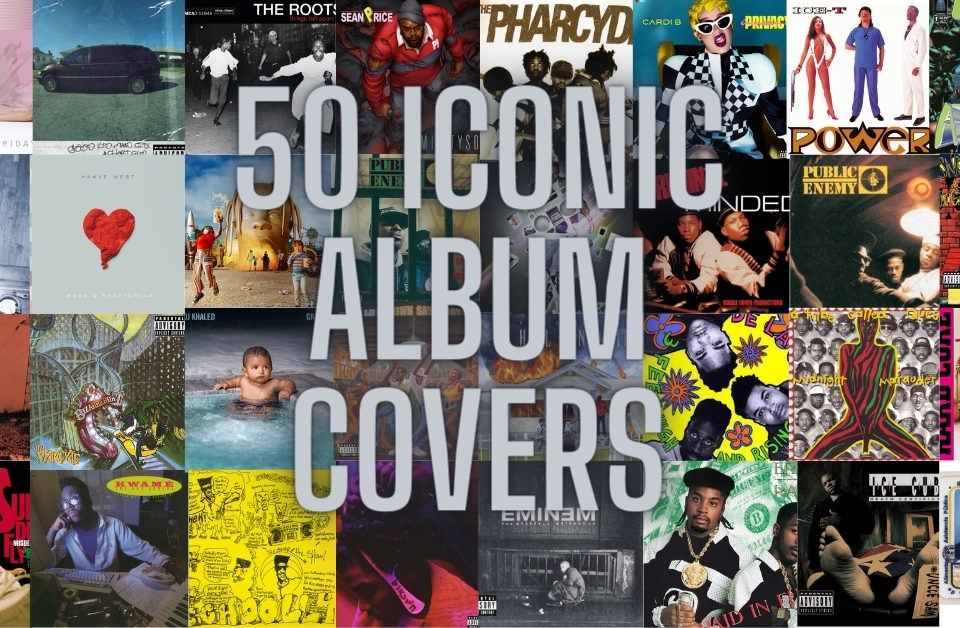1. Eric B and Rakim, Paid in Full
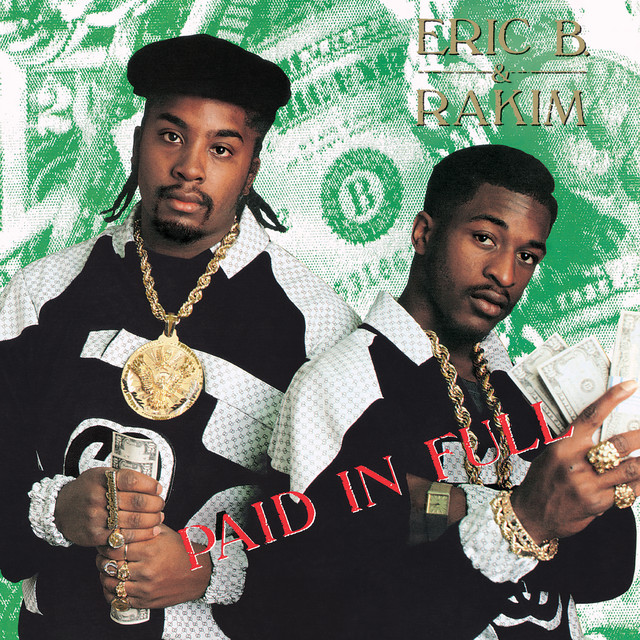
The front cover from the album Paid in Full by Eric B and Rakim is one of the most iconic pieces of art that rap music has ever produced. It represented an entire generation of Hip-Hop, allowing anyone ever curious about 80’s street culture, an intimate glimpse into the movement. Just look at the cover— the big Bennies floating in the background, the trunk jewelry, the classic hustler poses, and Ra’s iconic haircut, not only edified the lyrics on the album but cemented in our minds what New York was like at the dawn of rap’s ascension. Paid in Full was the epitome of the city’s street game, lyricism, and hustle all wrapped up into one rhythmic bow. An added Easter egg is on the back of the cover where the actual Paid In Full Posse from Brooklyn was featured. In addition to Eric B. and Rakim, you can see another rapper Kool G Rap from the Juice Crew (on Rakim’s right), who was kind of down with PIF; 50 Cent (crouching in red hat); Rap (top left in the FILA tracksuit); Killer Ben (top in green); Ant Live (crouching behind 50 Cent); Keith Green (from Long Island); AJ (from Queens); Freddie Foxx; Rob Garcia (from Long Island) and Jason Riley (in black). What made the album cover even doper was that the music on the album was top-notch.
2. Outkast, ATLiens
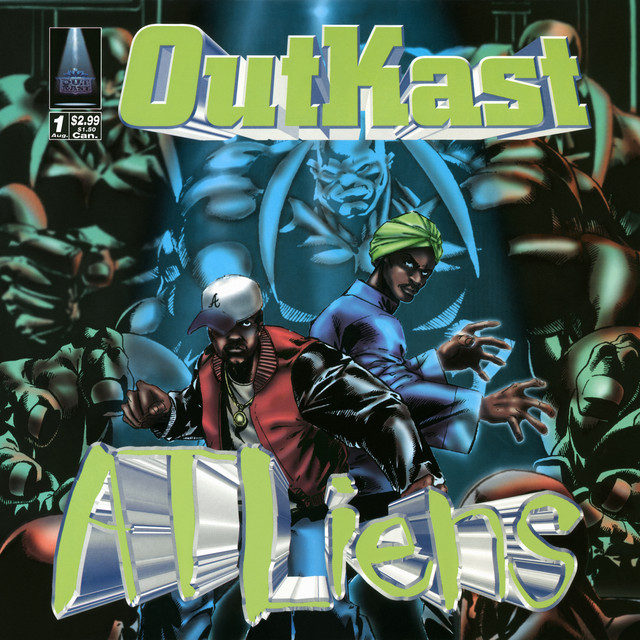
What made OutKast’s ATLiens cover so important is that it was their sophomore effort and the first time they were able to share with the world their “King” mentality, a mindset that some have termed the Southern alternative. Using this hyper-imaginative cover that portrayed them as comic book characters, they invited you into their genius while drawing license from George Clinton’s funk movement of the 70s and 80s. Art students, Nigel Sawyer and Vince Robinson not only pulled from Clinton and the Parliament collection of visually awesome album covers but were inspired by Todd McFarlane’s Spawn. They linked up with a team to deliver not just this epic cover, but also a comic book inside the cd—attached to the liner notes. Oh my GAWD! The characters were sketched and created by OG comic book illustrator Frank Gomez; fans were able to see both rappers in a newly imaged way … as the Hip-Hop superheroes that they are.
3. Public Enemy, Yo! Bum Rush the Show
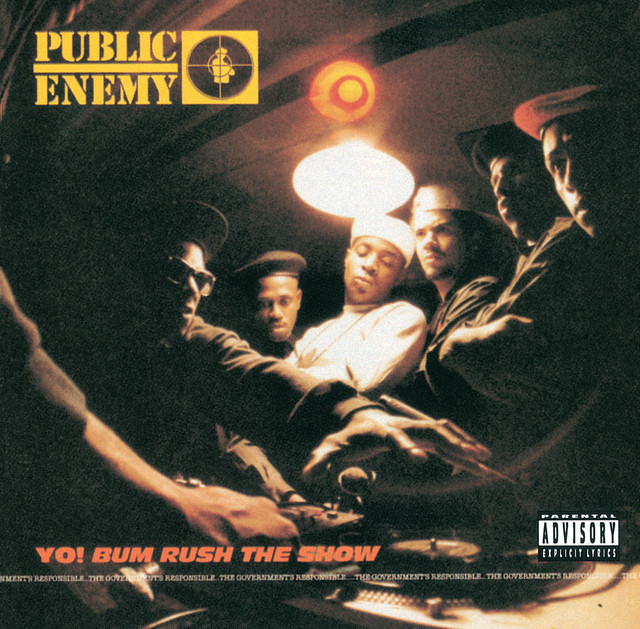
Yo! Bum Rush the Show’s cover art is a remarkable piece of work that epitomizes the artistry and disruptive nature of Hip-Hop in the 80s. The shady photograph used on the cover is of members of their Bomb Squad, Chuck D, Professor Griff & the S1Ws, and Terminator X “bum-rushing” a radio show and taking over whatever the DJ is spinning to control the turntable’s musical conversation. With this project, a 26-year-old Chuck D became the voice of a generation, coining the idea that rap music is the “CNN of the Street.” Little did he or anyone on the cover know that they would change the trajectory of the art form — bum-rushing the culture as they have done on this cover.
4. Ice-T, Power
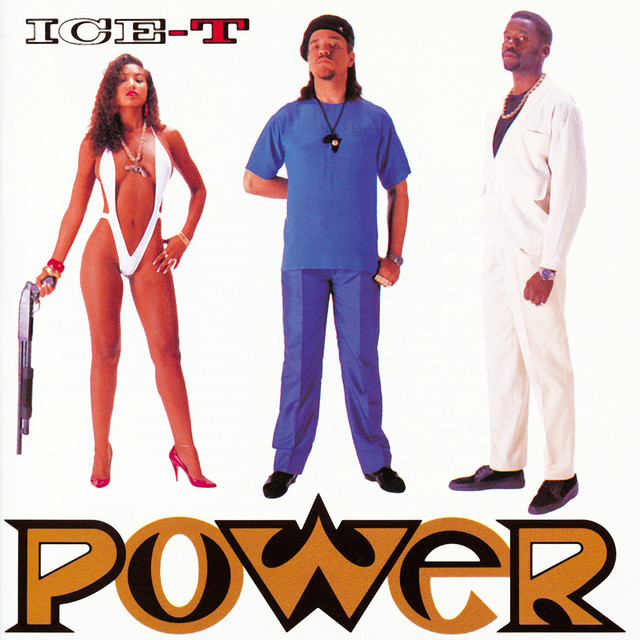
Before NWA, Ice-T was dubbed a spokesperson for the West. The precautionary tales mixed with his syncopated cadence distinguished him from the other rappers coming out of California. So when he dropped the album Power, he wanted to make a statement that was “powerful” and bold. What statement could be more powerful than a sexy woman in a skimpy bathing suit with a big gun, with two brothers standing stately beside her? If you turn to the back of the cover, you see that they are also packing military-sized heat. In talking about the cover, Darlene Ortiz, Ice-T’s former girlfriend, said, “I look back at that picture and think, ‘Girlfriend, you have no idea what’s getting ready to unfold after that’ … I was just happy to represent and do for my man what we were both intending to do which was to help out his career.”
She continued, “People forget – especially when they see my solo picture – underneath our three poses it says ‘Power.’ People forget that’s what it was representing. I’m very proud.”
5. Ice Cube, Death Certificate
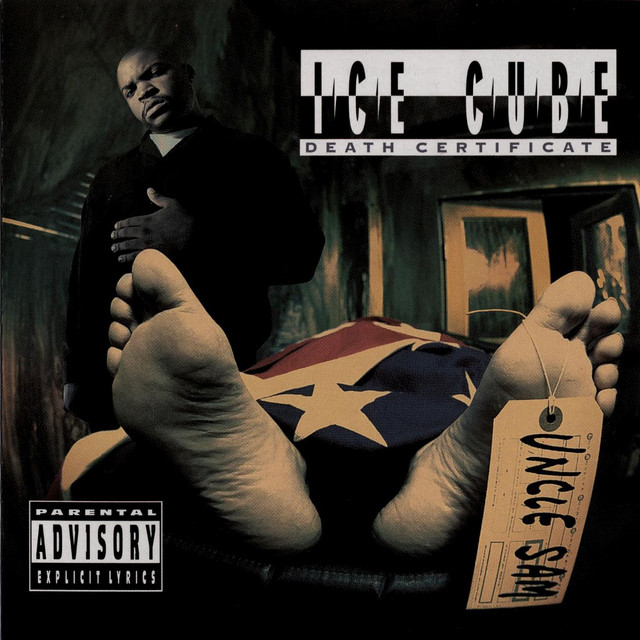
Did you know that Ice Cube, the old Cube, was not fooling with politicians on no level? He didn’t trust them and in a lot of ways appeared to be an anarchist. At least, that is what the government thought. Riding of the national controversy he garnered from being a founding member of NWA — a group that plopped on the FBI’s most-wanted list for their explosive song, “F**k the Police — Cube released Death Certificate in 1991 with the same level of anger and institutional distrust. On the cover of Death Certificate, he showed “Uncle Sam” lying dead on a mortuary gurney. The image was a visual illustration of how graphic the songs on the album were. Dropped during a time where Black people were not afraid to voice their disbelief and disillusionment of the American dream, the old Ice Cube had his finger on the pulse of the nation. Well, at least 12% of the nation. Other people were upset at his audacity. Billboard magazine may now celebrate his genius, but back then they condemned the project, starting first with this cover.
6. Nas, Illmatic
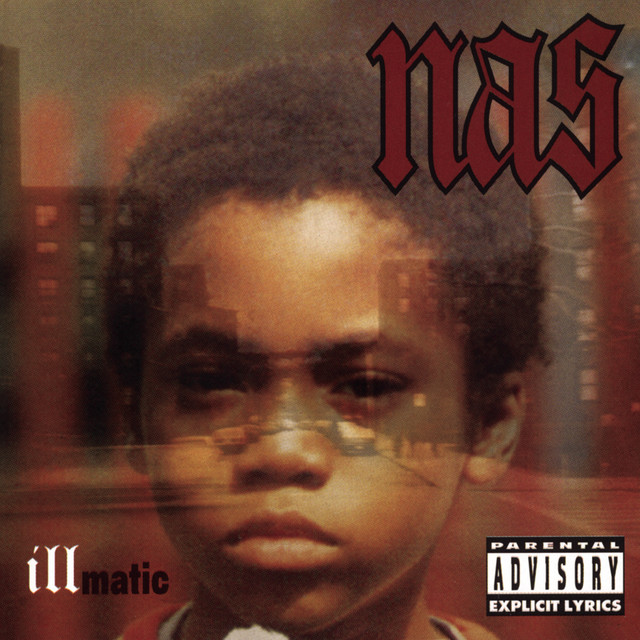
From the gate, Nasir Bin Olu Dara Jones wanted you to know that he was an extraordinary mind with influences that far extended the 26 buildings of Queensbridge projects. That, his level of quiet genius, might have been what attracted the young emcee to Q-Tip and Large Professor from the gate. And we get a glimpse of that on the cover of his debut classic album, Illmatic. On the cover, the fan gets to see Nas’ 7-year-old face superimposed in front of his projects. This layout is a tribute to a jazz act called Howard Hanger Trio’s 1974 joint A Child Is Born, where a young girl is phased in front of her version of the hood. He might have been exposed to them by his father, who was a notable jazz artist.
Nas says that for him, the inspiration also came from the King of Pop. “I’m a big Michael Jackson fan,” Nas said once. “I’ll tell you something I never said. On my album cover, you see me with the afro, that was kind of inspired by Michael Jackson – the little kid picture.”
A classic image for a classic album that gave the world a classic artist.
7. Kendrick Lamar, To Pimp a Butterfly
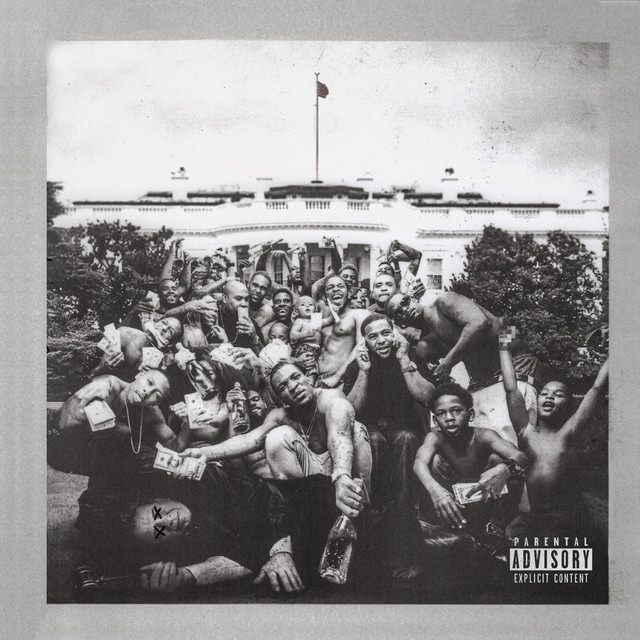
The To Pimp a Butterfly album cover is an example of the uninhibited joy and expansive opportunity that comes when someone from the hood makes it. The black and white image features Kendrick Lamar’s community peoples outside of the White House posing as if they are at a block party. Complete with that familiar competitive floss one has in a posse shot when they want to have the most crazy look in the snapshot, there are all kinds of sacred elements of the hood woven into the flick like stacks of cash, bare-chested machismo, and champagne bottles. On the bottom with his eyes, X’ed out is a judge, a representative of all of those who have yielded power and discrimination toward the people featured and failing to see their humanity.
8. A Tribe Called Quest, Midnight Marauders
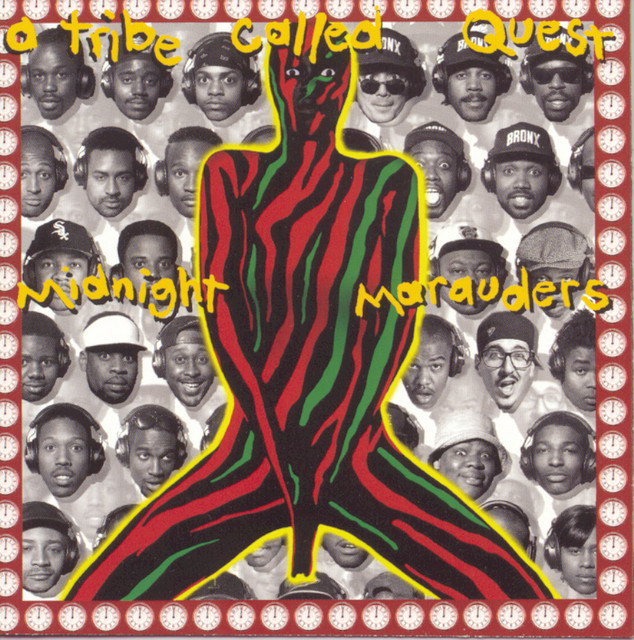
What makes A Tribe Called Quest’s Midnight Marauders album cover and sleeve notes legendary are the over 70 of Hip-Hop’s pioneers featured on the cover. For the most part, they are wearing headphones as face after face represents the personality of a specific artist, crew, era, and/or movement in rap music. The group used what has become a trade symbol of their brand, the red, black, and green striped Black woman. Red, black and green are the colors for The Pan-African flag designed by Marcus Garvey in the early 1900s.
9. De La Soul, 3 Feet and Rising
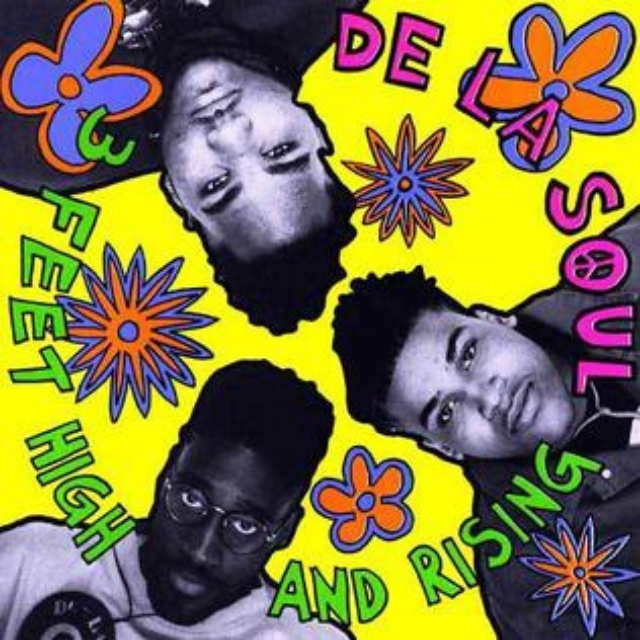
De La Soul’s 3 Feet High and Rising is not only a fire looking cover but historical. With all of its psychedelic-daisy age power punch, which makes it a groundbreaking project is that The Grey Organization was at the helm of it. GO believed that they wanted the cover to be “a move away from the prevailing macho Hip-Hop visual codes” which dominated rap culture up until that time. For fans, we just appreciated how light and fun it felt. We loved how even the colors afforded the fans an escape from all of the drama that they faced in their everyday life. Truly the perfect introduction to the group.
10. Beastie Boys, Licensed to Ill
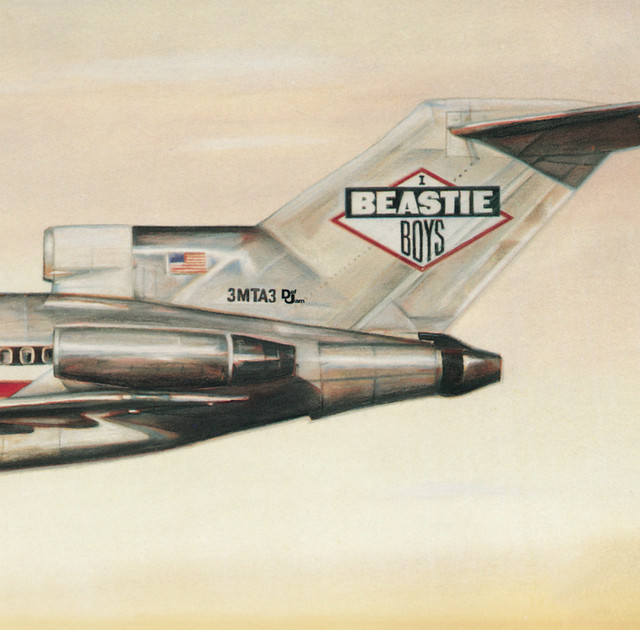
When the Beastie Boys dropped Licensed to Ill in 1986 it shifted rap music from one space to the next. For one, it was the first rap album to top the Billboard charts, becoming one of the fastest-selling debut records in Columbia Records’ history. Few can dispute that the music on the project was cutting edge and pushed boundaries by merging their punk roots with New York’s rap scene. As the first white group to really blow in Hip-Hop, the cover simply had to be as epic as they were. And it was.
Inspired by the Led Zeppelin biography titled, Hammer of the Gods, Def Jam founder, and producer Rick Rubin came up with the brilliant idea that had the rap group’s private jet crashing into a side of a mountain in such of a way that it conjured up the imagery of a joint been smushed out in an ashtray. So iconic was this image, that Eminem replicated it on his 2018 Kamikaze album.
11. Snoop Dogg, Doggystyle
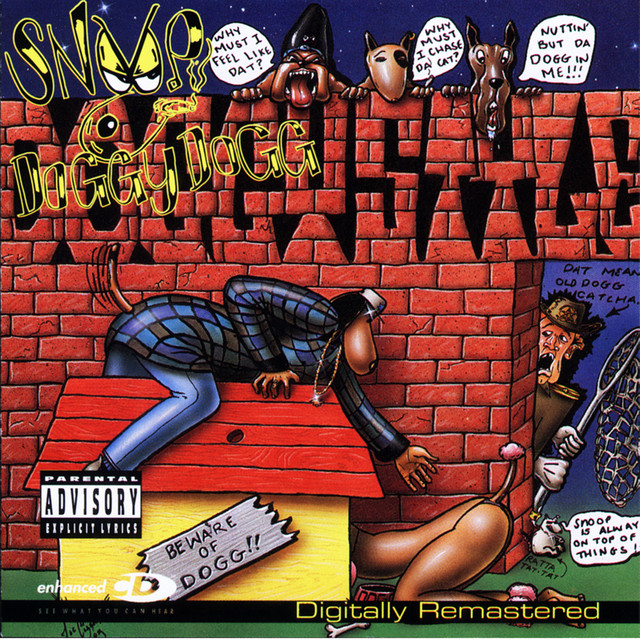
Did you know that Snoop Dogg’s Doggystyle album cover was drawn by his cousin, Darryl “Joe Cool” Daniel? The primary colored-sleeve had sexually explicit images that transformed the Fritz the Cat type of cartooning into a canine visual delight. Draped across the top, you can see quotes from George Clinton’s “Atomic Dog.” Over the red brick wall, to the right on Snoop’s name in graffiti, there are three dogs: a bulldog saying, “Why must I feel like dat?” a honey tree evil eye saying, “Why must I chase da cat?” and a brown Great Dane saying, “Nuttin’ but da dogg in me!!!”
Smacked dab in the middle of the cover saying, “Beware of Dogg ” on the outside of a doghouse, with a fictionalized Snoop as a dog reaching for a bare-booty of a female poodle. It was really the perfect intro into the Doggfather’s world.
12. Lauryn Hill, The Miseducation of Lauryn Hill
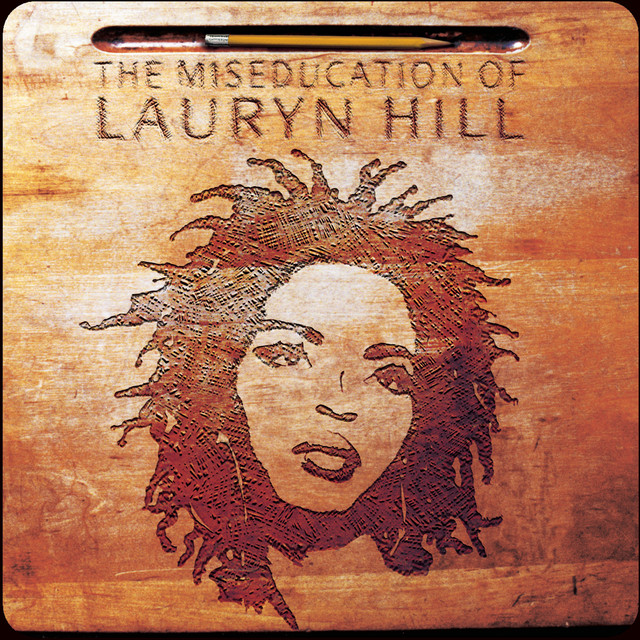
Arguably one of the most important albums in Hip-Hop, the 1998 release of The Miseducation of Lauryn Hill merged rap music’s honesty with the full gamut of love expressions found in R&B. The cover represented the theme of the project, threaded throughout its 16 tracks and interludes. On the front, there was a replication of a wooden school desk, with her face carved in. Her face, framed by her lovely locs, seemed to stare off (as students usually do). Undeniably Black and Caribbean influenced, many have likened the simplicity of this cover with the burning of the portrait into the imagining of wood to the Burnin’ cover from The Wailers. A nod to the Marley family, a clan that she later found herself intimately in a relationship with as her children are the grands to legendary Tuff Gong.
13. Logic, No Pressure
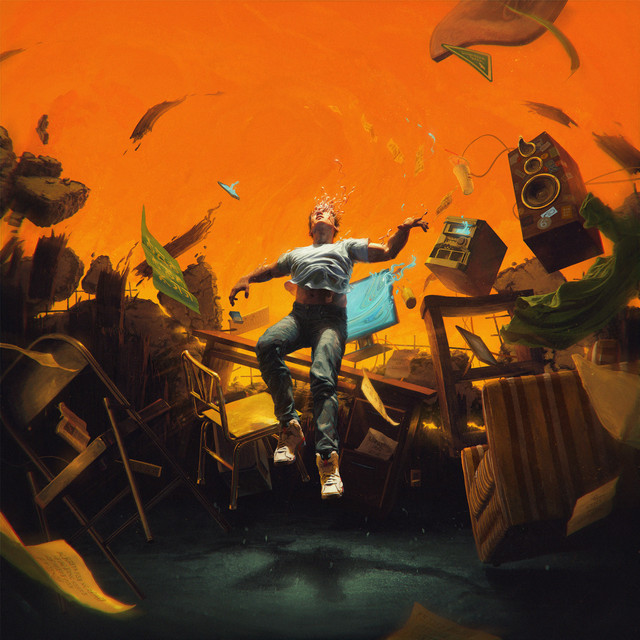
After announcing he was going to retire, Maryland rapper Logic released his latest project No Pressure. Landing him on the list with a highly emotional album cover that captures not just his feelings — but the feelings of so many people in his generation. It highlights a nondescript man, who is drowning in the orange ambiance of his everyday life. His body is floating and no one can actually tell if he is falling down or ascending from the buoyancy of water. There are speakers, television monitors, chairs, and other things caught up around him speaking to how so many Millennials and Gen Zers are just as overwhelmed by their stuff as they are with the pressure that they receive to be great. Truly left up for interpretation, the title of the project, Logic’s personal testimony, and indeed the state of the world in 2020 — encapsulates the feeling of dire straits that this generation finds itself in.
14. Lil Kim, Hardcore
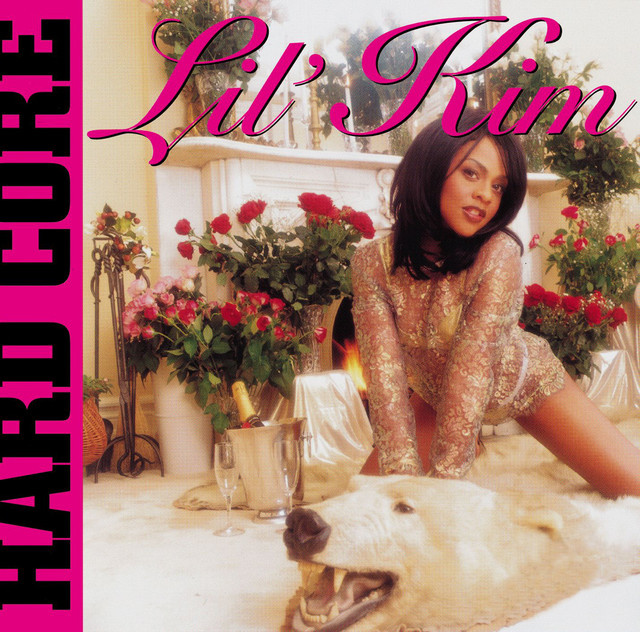
The album cover and sleeve images of Hardcore grew more young men (and women) up in the 90s than Playboy or Hustler combined. Who didn’t have the images made into a poster and plastered on their bedroom wall? Who wasn’t intrigued by the way she stared into the camera’s lens and invited you into her Brooklyn?
All 4’10” of her oozed sex appeal, but what was most intriguing was the thin line of freaky sophistication that assured you that not just anyone could have her. Her provocative posing was coupled with a level of exclusivity that is lost on this generation of rap sirens. And at the same time, her face screamed “fly girl from around the way” making her also über accessible.
15. Mos Def, Black on Both Sides
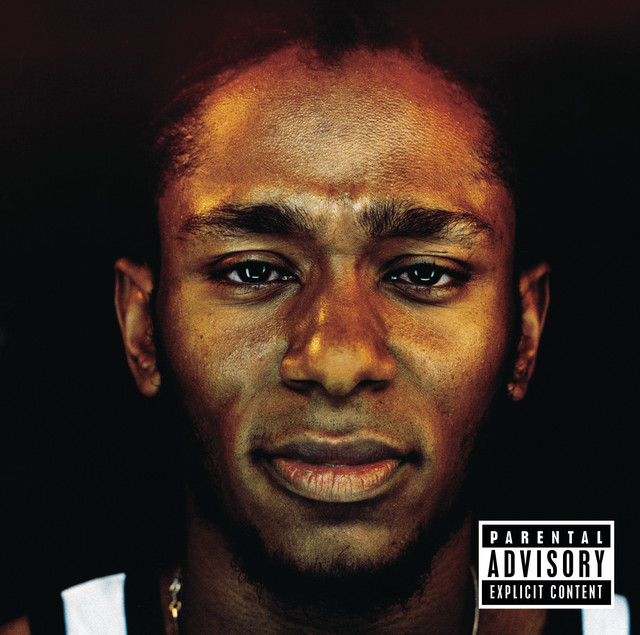
Mos Def’s bronze-tinted countenance, framed by a powerful black colored background, on the cover of his seminal work Black on Both Sides is at the very least a work of art. A perfect complement to his musical debut solo album, the LP’s optics helped define him as an artist. Stripped down and boldly African, the cover was purposefully stark and proved Mos to be the most unapologetic artist of his generation. Shout out to Alvaro Gonzalez-Campo, the photographer, for insisting on red and yellow gels to accentuate Mos’ face making the cover stand out in 1999 like magic as an incredible portrait of the man that would one day become Yasiin Bey.
16. Travis Scott, Birds in the Trap Sing McKnight
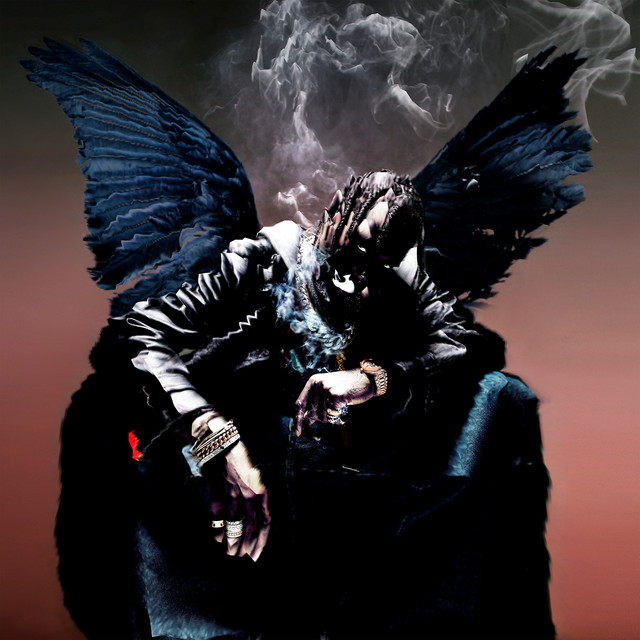
Travis Scott’s album, Birds in the Trap Sing McKnight, was a hit project from the moment it dropped in 2016. Sure people can point to his signature sound, but clearly, there were other elements to its success that simply can’t be denied. His electric personality. His unmatched attention to alternative culture. And the freaking rock star of a cover that brings back memories of the artist of your favorite comic books from the 90s. In fact, Trap Sing McKnight reminds you of Todd McFarlane’s popular antihero Spawn, a man who lost his soul to the devil in the Image Comics. Surprisingly, the photographer Nick Knight said that he was more inspired by the artist than anything to make this phenomenal cover, “It’s a real reflection of Travis. I was picking up the aesthetic that Travis has already shown, and to some degree, picking up on an image that might hold some resonance with the title of the album.”
“I thought he was a real inspiration to work with. It’s seldom you meet people with that desire to be so physical, to create performances through that complete physical exertion. The unique thing was his desire to create those exceptional shapes, as an image-maker, that was really inspiring.”
He further said about working with Scott on the cover, “I thought he was a real inspiration to work with. It’s seldom you meet people with that desire to be so physical, to create performances through that complete physical exertion. The unique thing was his desire to create those exceptional shapes, as an image-maker, that was really inspiring.”
17. Ol’ Dirty Bastard, Return to the 36 Chambers
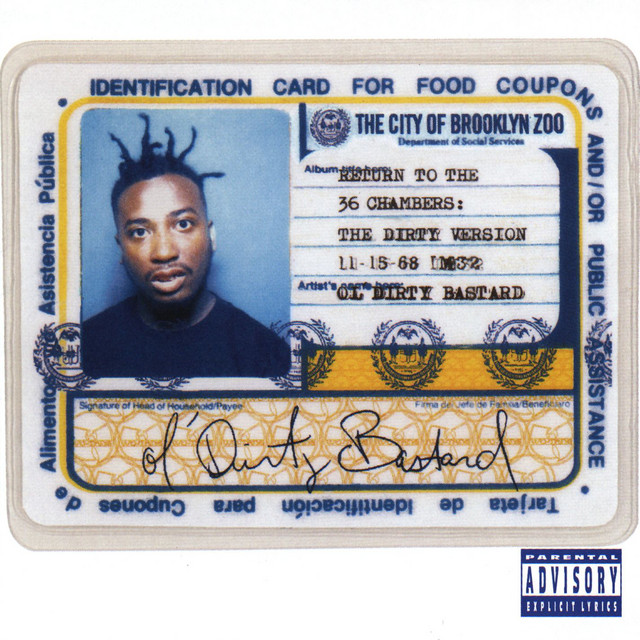
Who else but Ol’ Dirty Bastard would be crazy or bold enough to make his New York City public assistance card the cover of their debut album? When Dirty dropped Return to the 36 Chambers in 1995, people were aghast at the highly personal reveal … but not those who truly understood the realness of the “Brooklyn Zoo ” emcee. His honesty was on full display with the release of The Dirty Version but few understood the deep (unpopular as it might be) social commentary on welfare as reparations. He said once, “The people that want to cut off welfare, man, I think that’s terrible. You know how hard it is for people to live without nothin’? You owe me 40 acres and a mule anyway. For real.”
18. Lil Baby, Harder Than Ever
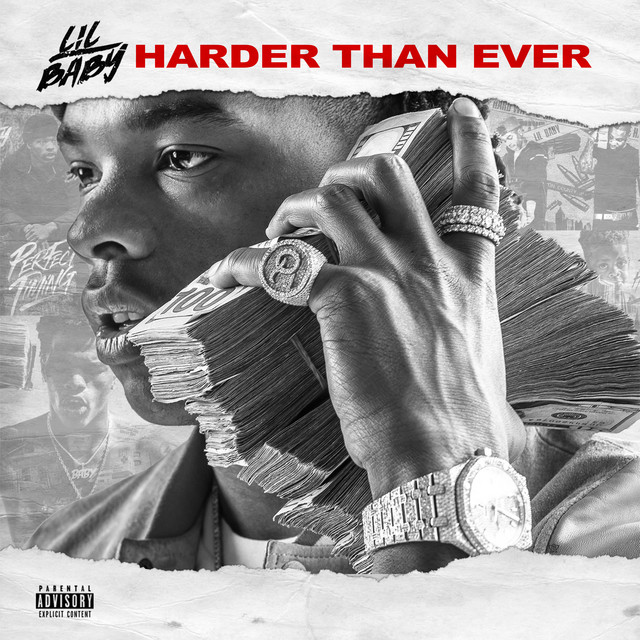
When Lil Baby dropped his debut studio album Harder Than Ever, his mind was on defining himself as not only an artist but as a mogul. The cover art reflects clearly the space where he sees himself, representing the trappings of success as painted by street lore. The black and white photograph has been stylized to resemble a pencil sketching of his profile, providing an urgency in his face that is matched by the vibe of this 2018 mega-hit album. But that urgency is not the most prominent character in this covers design. It is the multiple stacks of hundred dollar bills held up to his ear as if it is his telephone. The ostentatious display is called a “money phone” because essentially for many, “money talks.” It’s clear that he is flexing — but if anything it is showing his Hip-Hop genealogy.
Since the 80s, hustler culture has leaked into the artist space helping to shape the concept of “getting money.” The drug dealer and the hood emcee had a symbiotic relationship which is bonded by the umbilical cord of cold cash. Lil Baby’s cover, with his diamond-encrusted rings and watch (fans see his QC pimpishly big pinky ring), is a modern take on Nas’ lyric made-Jay-Z-hook, “I’m out for presidents to represent me.” It also reminds us of the Paid in Full cover that has been famously venerated by Hip-Hop fans. The “Bigger Picture” rapper is indeed flexing, but it’s the beauty of the cover makes this flex really a work of art.
19. The Notorious B.I.G., Ready to Die
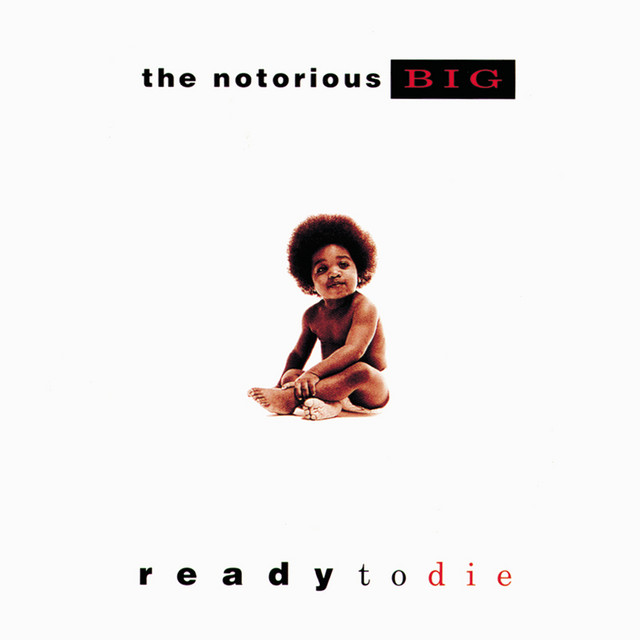
There are so many things to love about this simple image on Biggie’s debut album’s cover art. The juxtaposition of the title, Ready to Die, and the image of the afro-rocking Black boy (no older than 18 months) portrays the fear of so many African American men. Even in 2020, where brothers continue to invest in this conversation around mortality, is threaded with this notion that they are indeed born ready to die. Looking into Keithroy Yearwood’s face, the model who was paid $150 for the cover’s photoshoot and is now approaching 30 years of age, one must consider how powerful it must be for him to recognize his contribution to history. He probably had no clue that as a toddler he would contribute to the iconic narrative that rap music rightfully pushes: Black men are under attack.
Shout out to The Notorious B.I.G. brilliantly offered us a visual to that sad reality.
20. Boogie Down Productions, By All Means Necessary
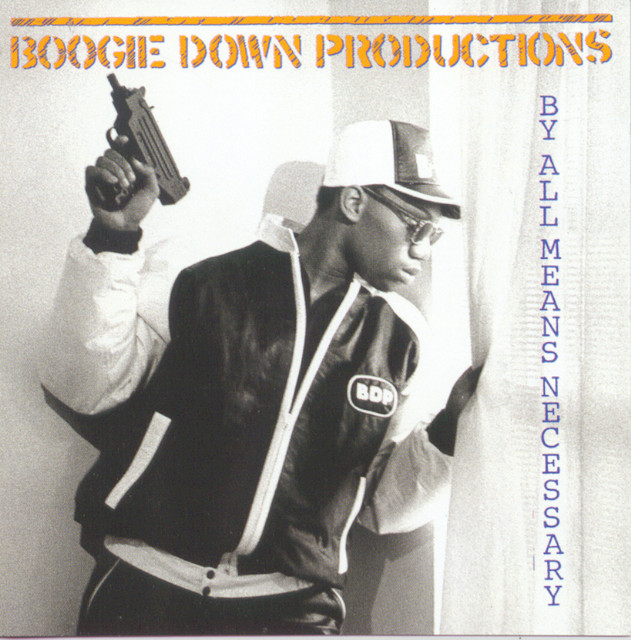
One of the most amazing albums ever to drop on wax, By All Means Necessary shook the music industry to its core as KRS-One took shots at everyone. Just look at the title, inspired by Malcolm X’s 1965 speech, “By Any Means Necessary” delivered at the Audubon Ballroom in Harlem, New York. The album cover spoke to this also. The cover was modeled after the 1964 image of the civil rights leader who was first seen in Life magazine (later Ebony) standing with an M1 Carbine in his right hand and pulling the blinds of the window of his Queens, NY home to the side with his left hand. By All Means Necessary pictures the rapper with an Uzi in the exact same pose.
No longer Criminal Minded, the Blast Master walked into his purpose as a philosopher, social disrupter, and intellectual freedom fighter.
21. Run-D.M.C., King of Rock
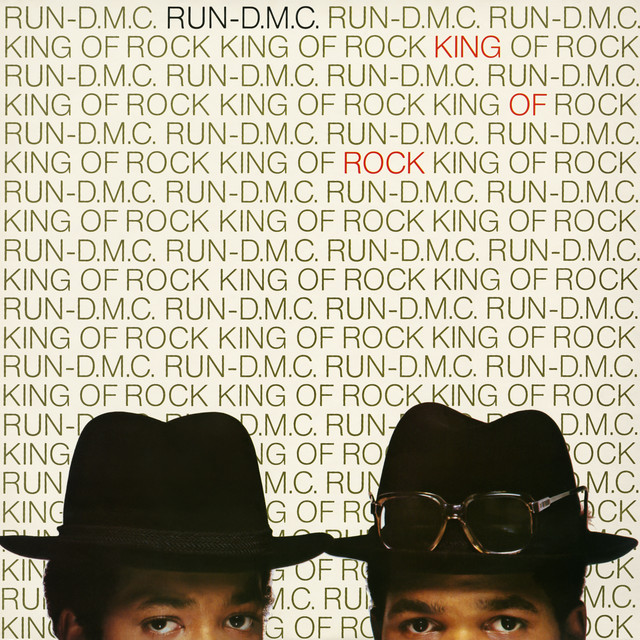
In 1985, Run-D.M.C. was the toast of the town. Two emcees from Hollis Queens took the title of Kings of Rock from every other act in popular music. They had the audacity to not just claim the chief monarch of all the “sucka emcees” in the culture flexing hard on the wheels of steel … Nah … they declared that they were over rock music. Basically giving the middle finger to Dire Straits, Phil Collins, Tears for Fears, Sting, Bryan Adams, Foreigner, and any other act that thought they were holding it down in the mid-eighties. To drive the point home, their album cover featured the two rappers peeking over the bottom with their names repeated over and over and over again like the Gucci jacquard.
For two years, King of Rock kept locking up the radio, MTV, and record store sales, making it not just a bold statement from the Profile duo but for them a triumph over the sophomore jinx.
22. Ghostface, Ironman
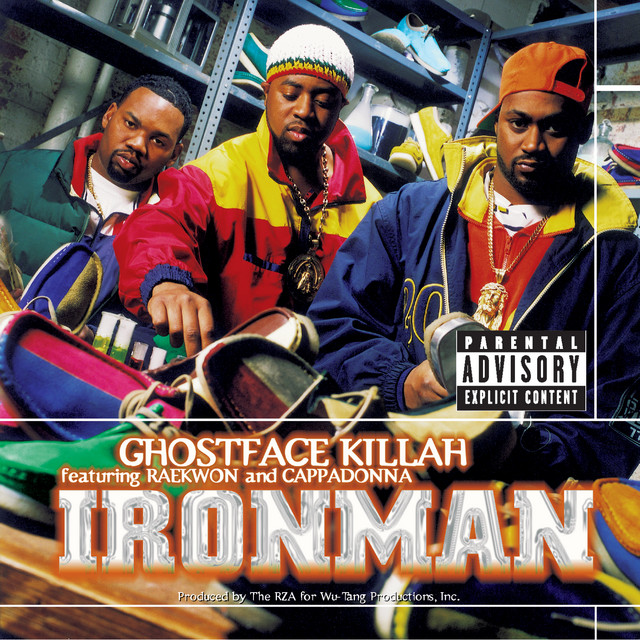
A few signature themes found in all of the Wu-Tang Clan’s lore are kung fu, killer bees, street culture, and comic books. These are threaded not just throughout the music that they produce, but also in The Clan member’s rap monikers and fashion sensibility. For Ghostface Killah, his second alias is Tony Starks based on the legendary Marvel Comics superhero. Starks is the real name of the fictional character, Ironman (hence the name of this legendary album). What made the cover so fire is that in addition to featuring Ghost, Raekwon the Chef, and Cappadonna on the cover, the art director chose another star to prominently highlight: Them Wallies.
Brightly decked out in primary colors, the cover shows this rap trinity surrounded by the NY fly guy’s alternative to the Timberland, a shoe called Wallabee Clarks. Once considered an old man’s shoe, Ghost’s affinity for them comes from the Jamaican hustle culture that saturated the North East in the 90s. Ironman’s cover said it without saying it, this record is made for a supreme clientele.
23. Conway the Machine, From King to a God
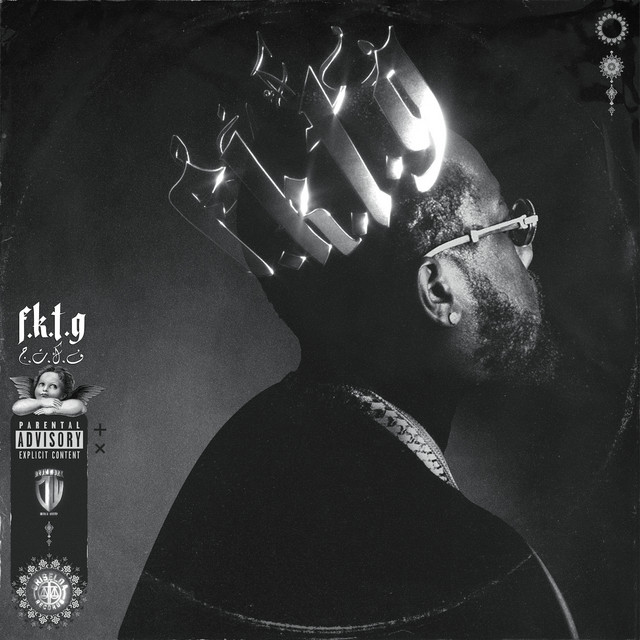
The world may be sitting back marveling at how swiftly the Griselda movement has taken over the landscape, but that’s because the culture has forgotten how all-consuming Hip-Hop really is. It is hard to see it coming. It is hard to deny it when it is there. It is dark and sinister, even as it is transforming life as we know it. This cover, luxurious with all of its black gradient, is a piece of art. Its expression, gradual and emotionally stirring, speaks to who Conway the Machine is to the rap game right now. From King to a God is a mindset conveyed eloquently by the tones and acronym in his crown, his positioning where he is looking forward to his success and his jewelry, drip that you know if powerful even as there is no color to assist in your determination.
There is also a biblical theme here. As he is referencing God, the artist gives a nod to the Exodus 33:20 scripture that reveals the Most High saying, “You cannot see my face, for no one may see me and live.” The Albany luminary is clear that in this game, none of the competition can see him.
24. Raekwon, Only Built 4 Cuban Linx
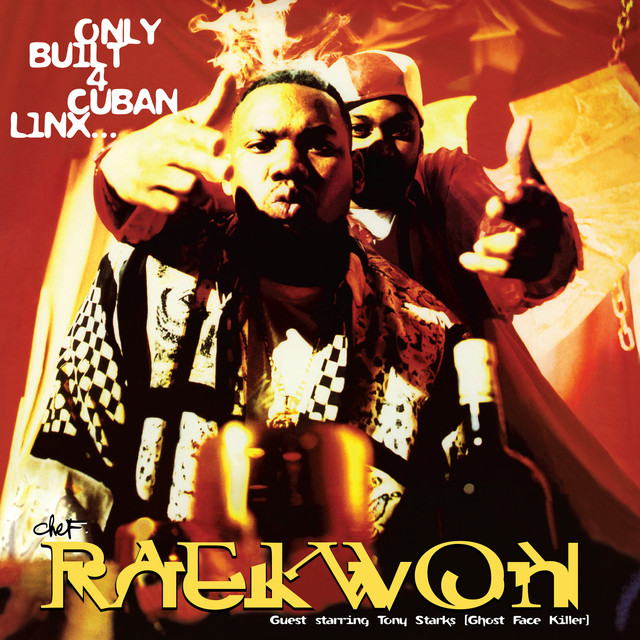
Raekwon’s debut album, Only Built 4 Cuban Linx, separated him and his partner in crime Ghostface from the rest of the Wu-Tang Clan by boldly embracing the nefarious street culture that defined their path to rap historicity. With the Wu “W” projected like a bat signal on the wall behind them, their brother is clearly communicated. Raekwon will block harm coming toward his beloved, and Ghost has his brother’s back with guns blazing. The red, yellow, and black, framed by smoke billows, chains, and booze, the cover art conveyed the core messages of the infamous “Purple Tape.”
25. DMX, Flesh of My Flesh, Blood of My Blood
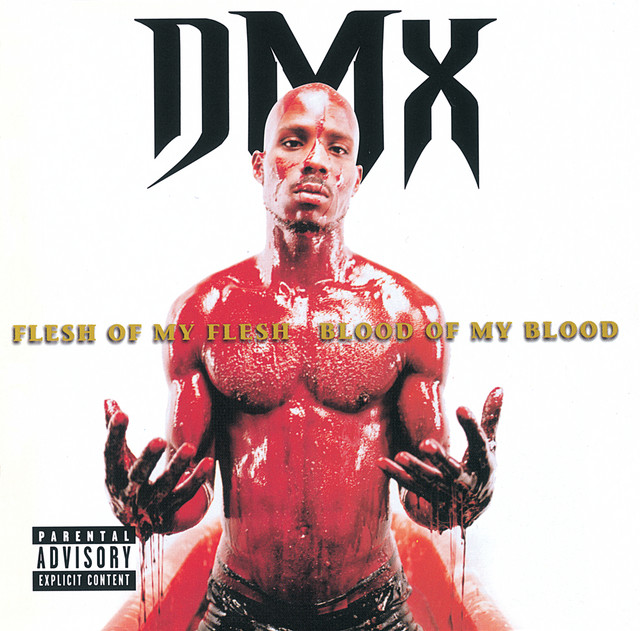
Drench in blood, as if emerging from a gory massacre, the goal of the Flesh of My Flesh, Blood of My Blood album cover was to share with the world the ugly journey that the Yonkers’ rapper had to dread to get to this point in his career. The shirtless DMX is not necessarily portrayed not as a monster. But if we are to look into his eyes, it is revealed that complicated angst that comes along with being a Black man forced to contend with the savagery of an unkind world.
Positioned in front of a solid white backdrop, Dark Man X is a sign of triumph. A frightful sign of triumph during a time when all he had to give was the flesh of his flesh, and the actual blood of his blood.
26. Tribe Called Quest, Low End Theory
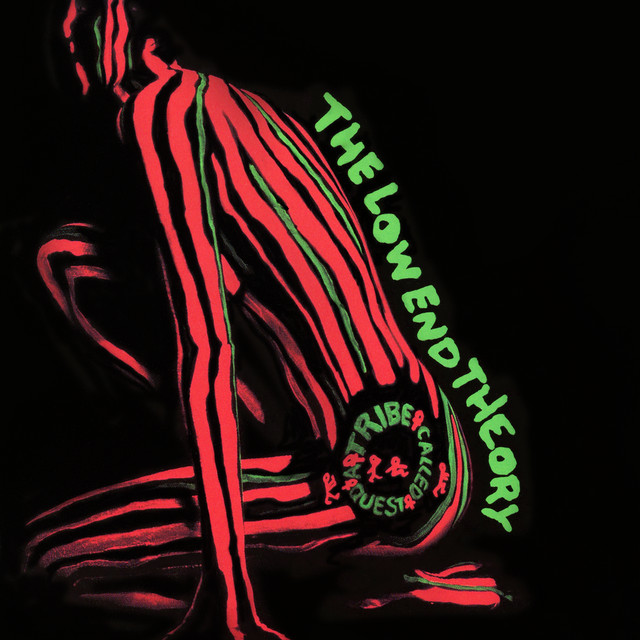
This is the first time that we see the unidentified (most likely female) red, black and green striped-humanoid logo that has so widely been associated with A Tribe Called Quest is on the cover of their Low End Theory album. The image has been so prominent in Hip-Hop that we almost believe that it is a progenitor of its own kind. But perhaps not. Many speculate that its inspiration comes from the many genres that actually inspired the original members of the group. The cropped kneeling from The Ohio Players’ Skin Tight album is remarkably similar to the Tribe avatar. The black space and vibrant colors of Steely Dan’s Aja can be cited as an influence also. However, the greatest influences are married to their Native Tongue tribe. All of them seem to have the same color palette to express their Afrocentric sensibilities that continue to define them as the parents of the Soulquarians movement that birthed so many of Hip-Hop’s most thoughtful artists.
This album cover has a humanoid crouching as if ready to spring into its future, and the colors that she carries in her body represents the whole of Black trauma, beauty and willingness to still expansively exist.
27. Tyler, the Creator, Igor
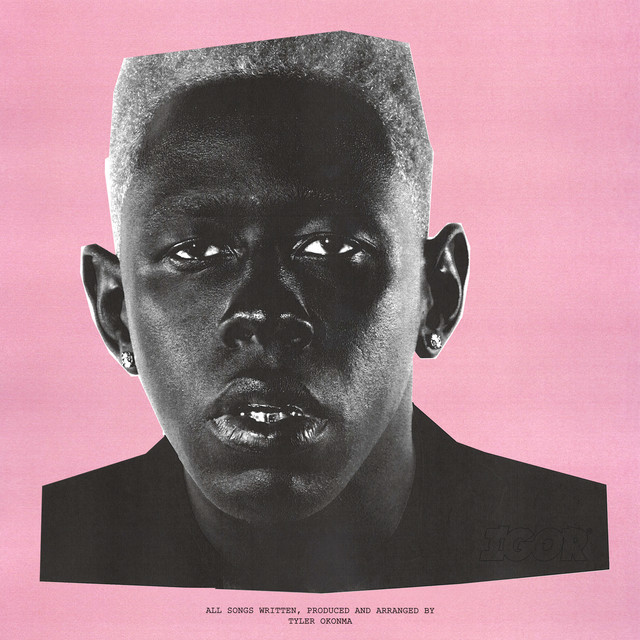
The imagery of Igor speaks to who Tyler, the Creator is as an artist – unpredictable and genius-ly creative. A dual image project, the Ladera Heights rapper pushes the boundaries in Hip-Hop with visuals that are more Basquiat than graffiti, more Lower East Side than SoCal, and mostly completely him over attempting to fit himself into a playlist that is not welcoming are in his artistic alignment.
One image is a seemingly underexposed self-portrait set in front of a Pepto-bispink background. The other, commissioned by Tyler, the Creator after connecting to an abstract artist on Instagram. Tyler, with this cover, stepped into the role as the Andy Warhol of rap music.
28. 2pac, All Eyez on Me
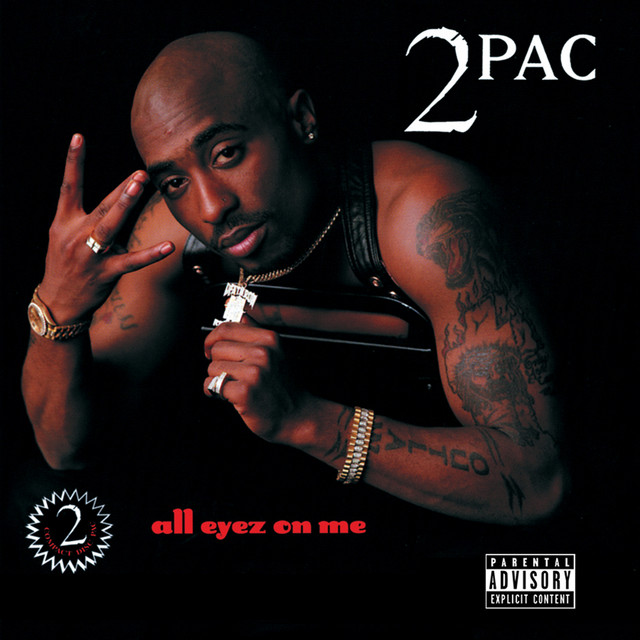
All Eyez on Me was 2Pac’s first album with Death Row Records. While the record was iconic, it was something about this soldier’s poise on the cover that spoke volumes about the next few stages of his life. His eyes were defiant and his posture was set with a confidence (and comfortability) that was not fully present in his other projects. Tattoos prominently swaying on his left shoulder, leading your eye to what was clearly his prized possession at the time: his Death Row medallion. Across from his hood-boastful display of his diamonded-out piece is his classic West-side “W.”
The four of the other sleeves show the semi-conscious prince in a new light. He seems to be getting money. One of them, in big red letters and image, was the Death Row logo. The entire flip is heartbreaking as we know in 2021 something he didn’t in early 1996 when the LP dropped — in seven months to the day of its release he would be released to the heavens. All eyes were indeed on him.
29. Nicki Minaj, Pink Friday
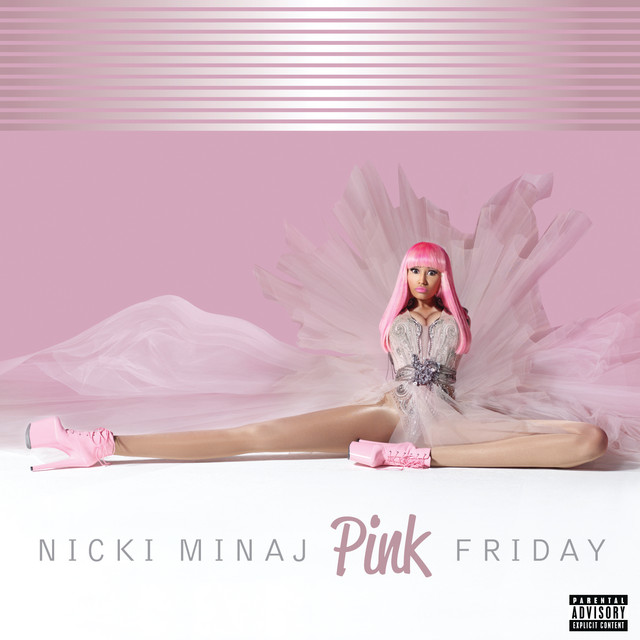
By the time, Nicki Minaj dropped Pink Friday in 2010, she was already a household name for Hip-Hop enthusiasts thanks to her conquering the underground circuit with her Beam Me Up Scotty and Barbie World mixtapes. Spinning off the animated theme of Barbie-dom, this cover featured her looking more like Ms. Malibu than the doll’s Black buddy, Christie. Nicki knew that for her to hit the top mark, she had to steal the best from the top Alpha girls: Lil Kim and the Mattel queen. With her elongated legs in a sprawling silver corset, pink stilettos, and a candy pink wig she fed the agalmatophilia that exists in so many in American culture.
Fantasy feeding, Nicki’s cover teeters on child-like pink imagery and silvery adult content. Pink Friday is iconic and weird because it was jarringly sexy, and disturbingly similar to an FAO Schwarz wonderland. And is making us look at these dolls our girls emulate differently.
30. Jay-Z, The Blueprint
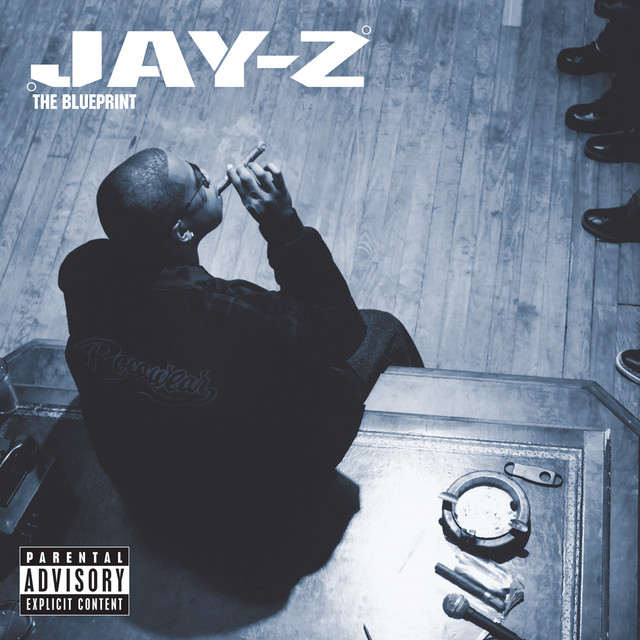
In 2001, Jay-Z dropped what was believed to be his road map to success — a project that gave the cheat code from the hood to the boardroom — called The Blueprint. Dressed in his own Rocawear brand and smoking a cigar while seated on presumably his desk, he seems to be giving instructions to a line of workers (as seen here in black shiny shoes). The blue filter cascades over the scene to highlight the title of the project.
But what actually epitomizes the concept of the album is the cigar, cigar cutter, ashtray, and the mic that is the foundation of his empire.
31. Kendrick Lamar, Good Kid, mAAd City
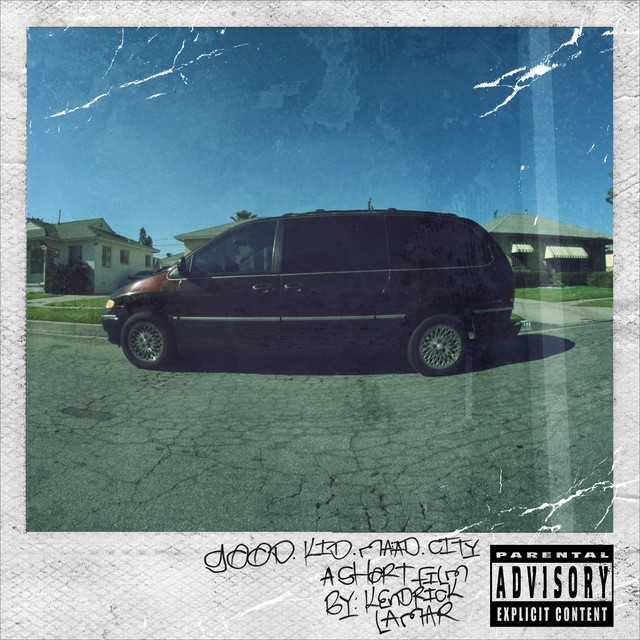
The cover of Kendrick Lamar’s Good Kid, mAAd City album is an actual childhood Polaroid from one of his family’s photo albums. It features his uncles, grandfather, and all kinds of elements from his hood. As his uncle flashes a gang sign, peeking out the Crip symbol from under K Dot’s arm, those who are analyzing the pic can see the old school baby bottle across from the 40 oz of malt liquor or beer.
The flick tells the story of a good kid in a mad city on its own, but in a way that is not intended to project judgment. Alas, it gives his fans a little of the foundation that affords the “Swimming Pools” emcee a pass in the hood and a seat at any table that he wants.
32. Redman, Dare Iz a Darkside
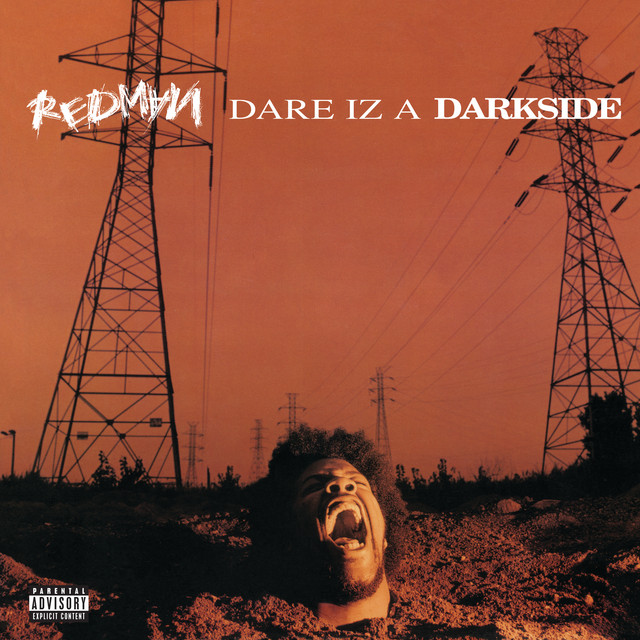
It is rumored that Redman (the Funk Doctor Spock) was inspired by the 1971 Funkadelic Maggot Brain album when he and The Drawing Board came up with the cover concept of Dare Iz a Darkside. The cover featured his shouting head coming out of the ground in front of several towers and was according to the artist, was shot during a time when he was in a dark space in his life. Saturated with red overtones, the cover is striking and was reminiscent of the chaos that was in Redman’s life circa the mid-90s.
33. Missy Elliot, Supa Dupa Fly
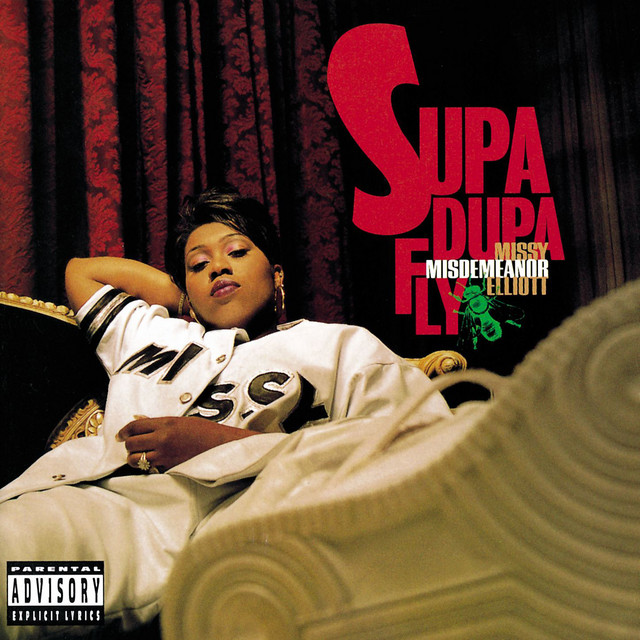
Supa Dupa Fly as an album cover was a stunt on the industry like no woman had ever done. No… the artistic direction wasn’t supa crazy. She didn’t overspend wild dumb on the budget to get it shot. But back in the late 90s, to have a plus-size woman to reclining back with her leg up with the posture of a boss, was simply unheard of. The colors were not feminine and soft. They were dark and powerful and she, the producer of a whole movement, set the tone for the next twenty years of a Hip-Hop heavyweight that transcended not only gender but also race.
At the time, she moved with a green fly on each sleeve of the album cover. Little did she know that in south-western nations in Native American culture flies are actually considered message-bearers or bringers of the first fire to humans … and with Supa Dupa Fly, Miss Misdemeanor brought the message that she was here to stay … and that with her presence she was bringing nothing but fire!
34. Kanye West, 808s and Heartbreaks
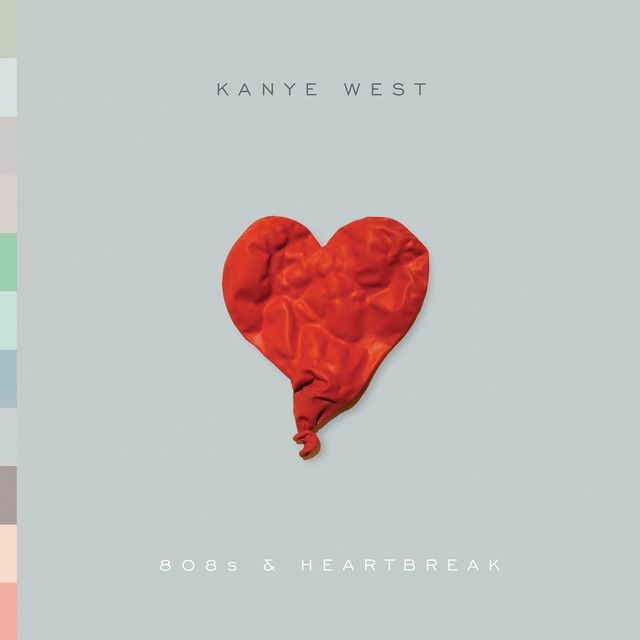
There are so many Kanye West album covers that are extraordinary. Any of the ones that featured his iconic bear mascot could easily dominate this list, as Yeezy is a 360° artist that sees, breathes, and creates genius in almost everything that he does. However, it was something that shifted when he made 808s and Heartbreaks. Perhaps it was Virgil Abloh (before Off-White was a thing) and Willo Perron from the Past Tell Museum’s art direction. Definitely, it was Brian Donnelly, the New York artist professionally known as KAWS, who made the Deluxe Edition. Yet so much of what made this particular project special was Kristen Yiengst’s photo of a deflated heart.
A bright red heart-shaped balloon stylized to appear broken and separated by Mickey Mouse gloves is set against a gray backdrop and signified an evolution in West’s aesthetic. What makes this so powerful … It is a pinpoint to when we started to lose the old Kanye.
35. The Pharcyde, Bizarre Ride II
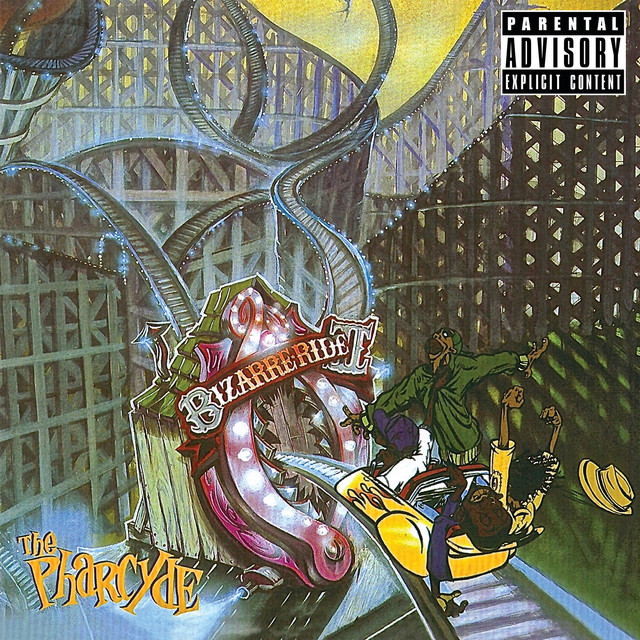
One of the best groups to come out of the West Coast is The Pharcyde: that is simply an undeniable fact. Their debut album the Bizarre Ride II sonically and lyrically carved out a lane for them that quickly cemented them in our minds as dope emcees. And the cover art of this album allowed us to revel in the fun-filled personality of the group. All four of the South Central Los Angeleans, Imani (Emandu Wilcox), Slimkid3 (Trevant Hardson), Bootie Brown (Romye Robinson), and Fatlip (Derrick Stewart), are portrayed as caricatures. Unapologetically Black, each of them purposefully have exaggerated features — big lips, kinky hair, extended limbs, and bulging eyes. As if mocking any stereotypes about their proud race, in one cartoon they flipped the entire narrative bringing their fans on a wild and crazy rollercoaster of a ride. A true bizarre ride …
The art shows them in one car of the amusement park ride zooming into a tunnel that actually is a vagina with teeth. Bizarre Ride huh … but we enjoyed every bit of it.
36. Kwamé, The Boy Genius
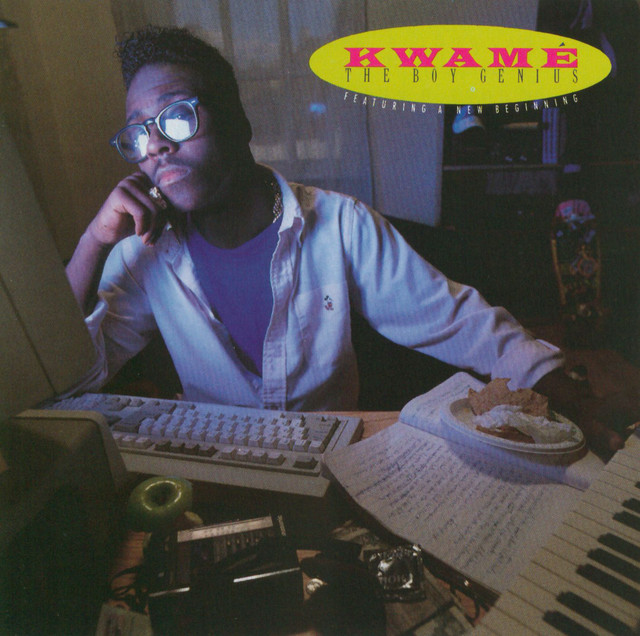
It is hard to imagine this, but most rappers from the 80s and 90s were teens when they came out. However, none of them stepped on the scene the way that Kwamé Holland did, which is why he was able to name his debut album Boy Genius and get away with it. On the cover, you see him sitting in front of an old school desktop with a pensive expression. The child prodigy, photo’d with schoolboy spectacles and a scribbled up notepad, could easily be doing his homework. But Nah, the keyboard on the side suggests something different.
It is easy to see that he staged to show his process that led to him putting out a classic, where he wrote the rhymes and produced the beats at 15 or 16 years old. In fact, he probably was perched the same way in 1990 when he also wrote the rhyme for Michael Bivins on the BBD hit song “Poison.” Either way, he represented the brilliance of young Black boys that create the art form that has allowed Drake, Pharrell, and DaBaby to thrive in 2021. The cover is classic because it reminds us that Hip-Hop came out of the incredible imagination of all the boy geniuses dreaming of a new way to express their reality.
37. The Roots, Things Fall Apart
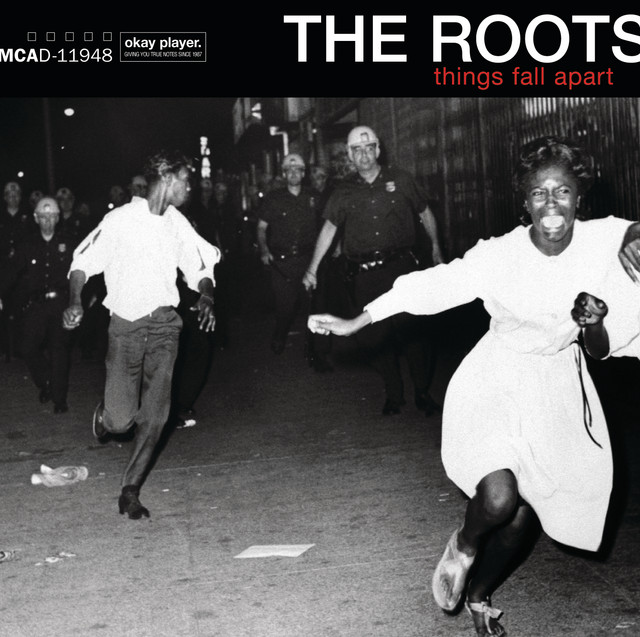
There were five covers for this legendary album cover for Things Fall Apart and each one was more iconic than the next — and all starkly worthy of gracing the list.
One was of Mob boss Giuseppe “Joe the Boss” Masseria who was holding an ace card in his hand after he was murdered by Benjamin “Bugsy” Sigel, Vito Genovese, Albert Anastasia, and Joe Adonis at the Nuova Villa Tammaro in Coney Island restaurant in 1931. Another cover was of a child stranded in the rubble at Shanghai’s South Railway Station in 1937 after the Japanese attacked the Chinese during the wartime conflict. The album cover that is the most recent was shot in 1992 and features a Somalian child crying because it is hungry — due to a country-wide famine exacerbated by civil war. Just as heart-wrenching is the cover that features a church bombing. While that image is horrific, what makes it more intriguing is that the date, location, and who shot it remains unknown by the group.
The cover that is most popular features a young teen girl running in Bed-Stuy from the police during the 1960s race riots during the fight for civil rights for Black people. It is befitting to see images from 2020’s summer that could easily be swapped with this one.
38. Travis Scott, Astroworld
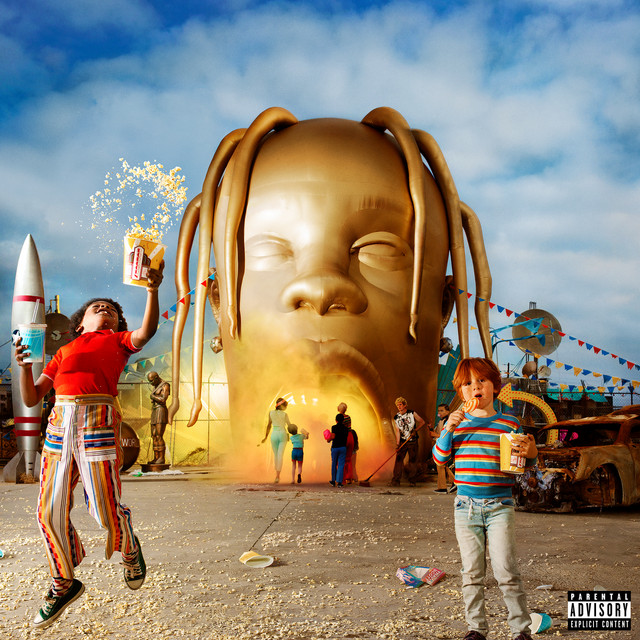
There are two phenomenal covers for Travis Scott’s Astroworld project. The first one featured two children (one of color and the other white) playing in front of his own carnival or circus. Shot by David LaChapelle, the famous photographer responsible for so much of Whitney Houston, Elton John, and Mariah Carey, fans see a child of color tossing up popcorn in the air while the other is eating his. The kids are standing outside of a golden entranceway of Scott’s face — where the door is actually his mouth. They seem joyful and blissfully anticipating their bizarre location of amusement. The second cover is a little less Rockwell-ish. The nighttime version resembles the old 42nd Street in New York City or a forgotten strip in Las Vegas. Contorted women are photographed half-naked suggesting a seediness that the other cover did not. Both images represent a duality that consistently exists in Scott’s work and help rocket (just like the missiles in both sleeves) his career to the mega-stardom it is in now.
39. Schoolly D, Schoolly D
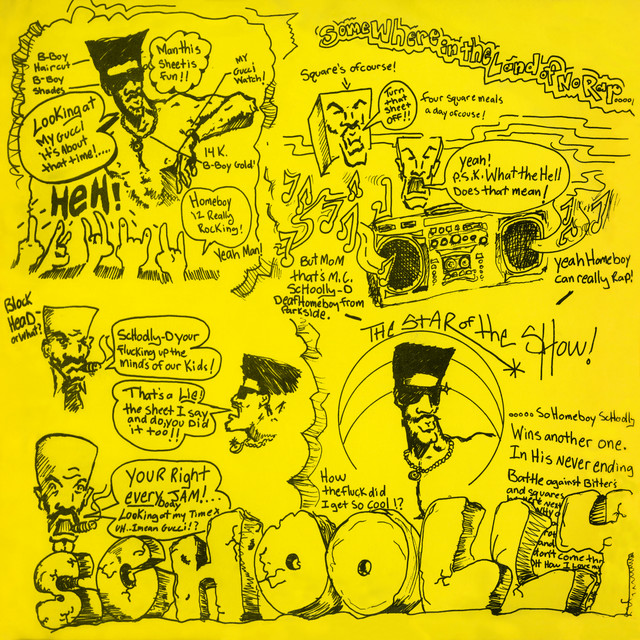
The first time the world got to meet the chief representative of the Park Side Killer Schoolly D was with the dropping of his 1985 self-titled album. Considered the Godfather of Gangsta Rap, his cover art incorporated hood sketch comics drawn in an old school graffiti style on a bright yellow canvas. Like the Doggystyle cover, it inspired almost ten years later, there are bubble quotes that recited lyrics to hit songs. The difference here is that instead of dogs yelping lines from another artist, Schoolly D had flat-top wearing fans reciting his rhymes. With their hands in the air, the cover is a storyboard of the lyricist’s popularity and how his songs “Gucci Time” and “P.S.K.” were hits almost everywhere.
Featured on the lower right corner, above the double “L’s” of his name is a self-portrait with a halo over his head. Next to the halo … There is a proclaiming title that says, “Star of The Story!” In the mid-80s, his cover was not rocking hyperbole. He indeed was the star of Philly’s rap story.
40. DJ Khaled, Grateful
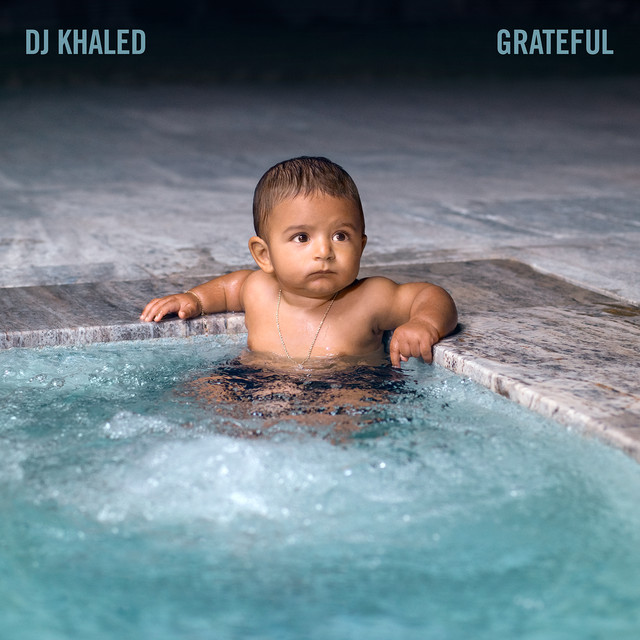
DJ Khaled has had a career in Hip-Hop for decades. Blending reggae/ dance hall with his love for pop-hitting rap has not only made him a bonafide hitmaker but an iconic personality that represents all things fly, luxurious and successful. But he also represents fatherhood. This is why having his firstborn son Ashad on the cover of his Grateful album, the first project after the child’s birth, was epic. One sleeve features an infant Ashad sitting in the corner of the Jacuzzi. Perfectly shot, it states what the “We the Best” mogul has expressed from the start of his career. As a man of color, Middle-Eastern in heritage deserves to live in America lavishly, basking in the fruits of his labor.
The other sleeve speaks more to empire than luxury. The producer is standing in a baby blue silk suit, sharply groomed and slimmer than ever, next to his young prince, who is matching in wardrobe and is mounted on his mini-throne. To the side of Ashad is a baby lion, so symbolic of the greatest that his dad forecasts for his future. Helping with his “blessed” future and sure a key to this theme of gratitude is the executive producer credit that Papa Khalid gave to the most celebrated baby in rap music.
41. Public Enemy, It Takes A Nation of Millions to Hold Us Back
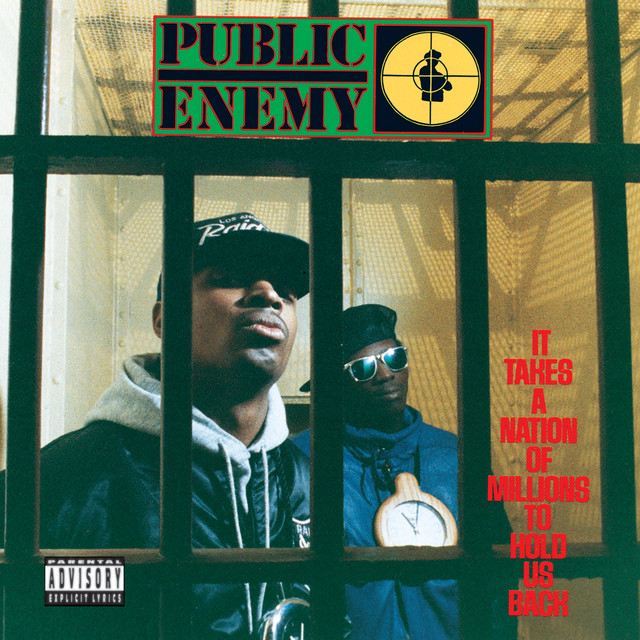
One of the most pivotal albums of all time, It Takes A Nation of Millions to Hold Us Back, as a cover is a bold stance for the golden aged architects that used rap as a protest. Set in a prison, the photographer Glen E. Friedman balanced the group’s energy with Chuck D’s smugged face of rebellion with Flavor Flav in the back signifying that the Thunder of Hip-Hop has backed up. In 1988, such an image cut through pop culture like a hot knife to butter. The logo smacked dapped in the middle reminded you that they were not here to cozy up to the status quo — Public Enemy wanted you to know whose side they were one. And to this day, the cover represents exactly who they believe themselves to be.
42. Sean Price, Mic Tyson
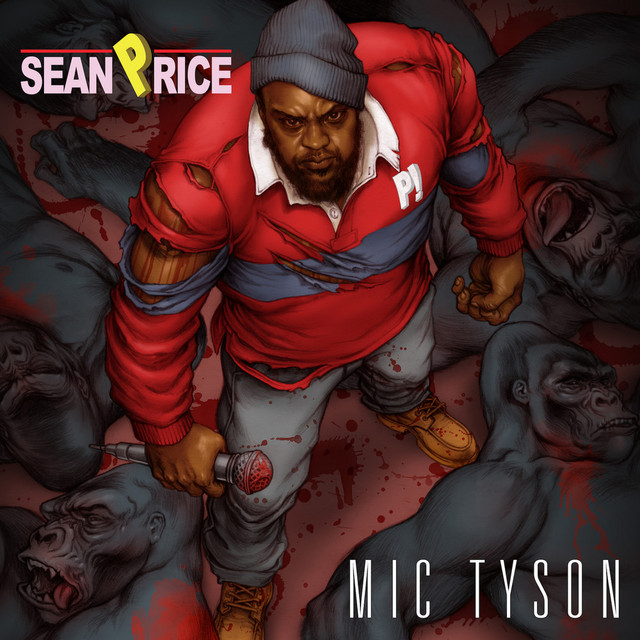
Sean Price is a superhero in Hip-Hop. The Heltah Skeltah member was slick with the lyrics and killed emcees faster than a speeding bullet and was rumored to leap tall Brownsville buildings in a single bound. And with his third solo album Mic Tyson, he decided to let the world know just how paranormal he is when it comes down to this rap game. The cover is another comic book riff, showing the deceased rapper in striped polo styled shirt with gorillas lying dead all around him. With a bloody mic in his hand, he peers up into the sky ready to rock and ape trying to grab his mic.
Titled after the other Brownsville superman, Iron Mike, the comic book character has the extraordinary power to knock out the rest of the competition. The cover clearly conveys the great Sean Price as we remember him … INVINCIBLE.
43. Camp Lo, Uptown Saturday Night
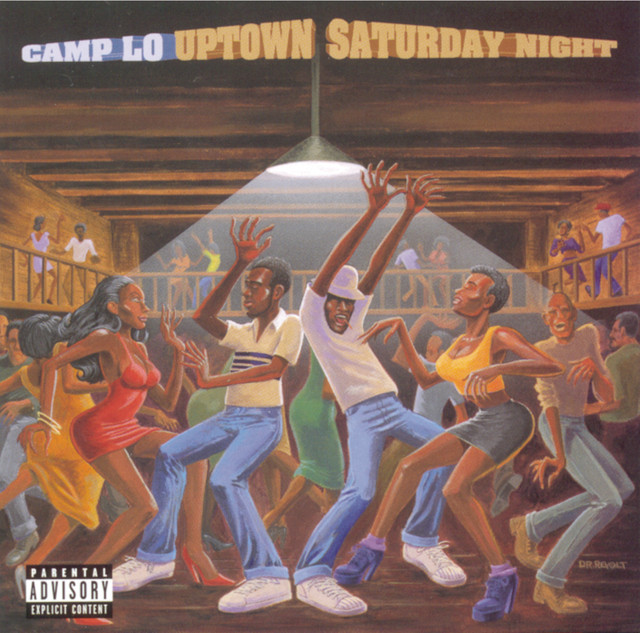
Why do people still love the Camp Lo album cover, Uptown Saturday Night, almost 25 years after its initial release? It is because that cool duo from Harlem was able to transport a very specific generation of Hip-Hop back to the 70s and 80s, a time before rap music was the most prominent genre of music in the world. The cover art made you think of Ernie Barnes’ piece ‘Sugar Shack’ that we were all introduced to via JJ from the hit TV show, Good Times. The dancers in the painting have exchanged their funky soul drip for the contemporary Kangol hat, jeans, and classic Uptowns aka Air Force Ones.
It also pts those who not only listened to the music but check out the cover in a groovy mood, invoking Marvin Gaye. If you did not see it as an homage to the Evans family, you recognized the riff on the Motown artist’s legendary album I Want You … an LP that also featured Barnes’ Shack on its cover.
44. Smino, Blkswn
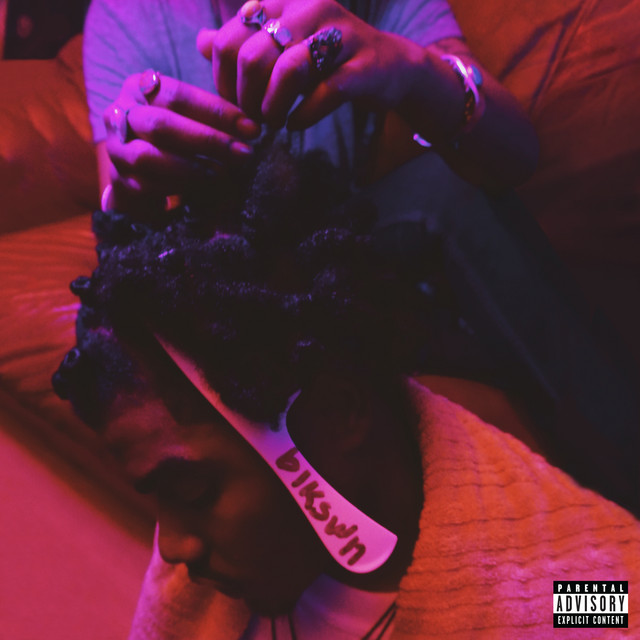
A wild card on this list is an act out of St. Louis named Smino that put out an album called Blkswn. The 2017 release might not have made a huge impact on the culture (despite the quality production and respectable flow), but the artist value and hood-inspiration on its cover simply is hard to deny. Smino appears to be getting his hair styled in twisted-knots by a lady with gem-stoned fingers. Hanging from the front side of his head is a wide-tooth comb with Blkswn written in thick-tipped Sharpee. A cascading red tone makes the scene warm and elevates the snapshot to another level.
It reflects something else … that this “Show Me State” rapper is thoughtful which is why talented artists like Noname and Rayvne Lenae have given him the co-sign.
45. Lupe Fiasco, Food and Liquor

Not your average rapper, Lupe Fiasco is a thinker and creative savant. So imagine the Chicago native staring at this skateboard deck and becoming so inspired by its reference back to Katsuhiro Otomo and his cover for Domu that he says has been turning up in his life for years that he and artists Chuck Anderson and Righteous Kung Fu mapped out the direction of his 2006 album Food And Liquor.
An out of this world sight, you see the artist floating in space with items of Blerdtopia drifting all around him. Domu featured, according to the lyricist, the principal character flying in the darkness while being surrounded by a collection of what seems like random objects. On his cover, the items not only pay homage to the Japanese manga artist’s art but are indicative of the variations of the project, and just by looking at it, fans are simply become engrossed by the technicolor of his mind. These items include a tattered Holy Quran diagonal to his boom box. He has sketches, school folders, devices, a dog tag, pins, a Nintendo DS, a CD, a stuffed doll, and even a Banksy postcard. On top of his head are crooked glasses.
But what was the magic? Green screen and some a really creative graphic designer. Lupe is laying on the green covered floor and the items were hung by a clear wire to give the illusion of suspension.
46. The Pharcyde, Sold My Soul (The Remix & Rarity Collection)
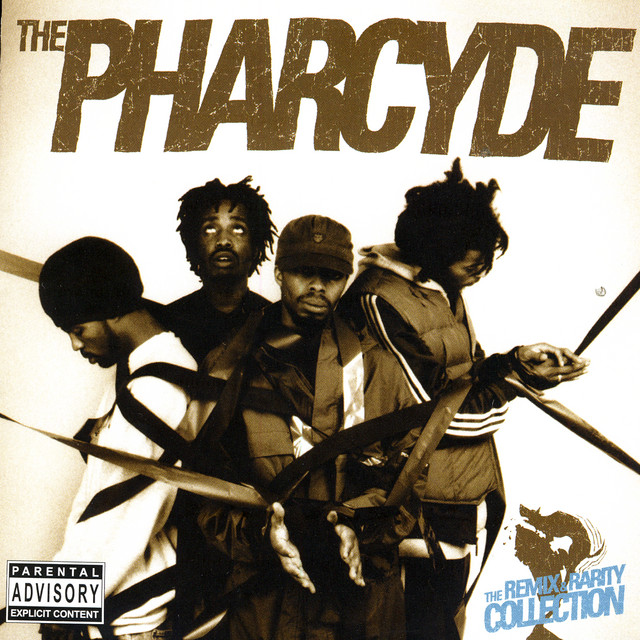
The Pharcyde makes a second appearance on the list with a compilation album titled Sold My Soul (The Remix & Rarity Collection).
Ten years before the drop of this “best of” LP, Brent Rollins (art direction) and Ricardo Martin (photographer) came up with the brilliant idea to stage the West Coast group Pharcyde in four directions (cheating with the North to peek out to the camera) and wrap them up in recording tape for the cover of Rap Pages magazine under the leadership of Sheena Lester. The group was promoting their sophomore project Labcabincalifornia but had great angst because their first album (which was 35 on this top 50 list) had done so well in the hearts of fans. Could lightning strike twice in the same location? The magazine cover captured this. The sepia-toned image did well for Larry Flynt’s biggest selling music mag and was so beloved by the talent that they used it in 2005. See, we aren’t the only ones to love this piece.
47. Vince Staples, Hell Can Wait
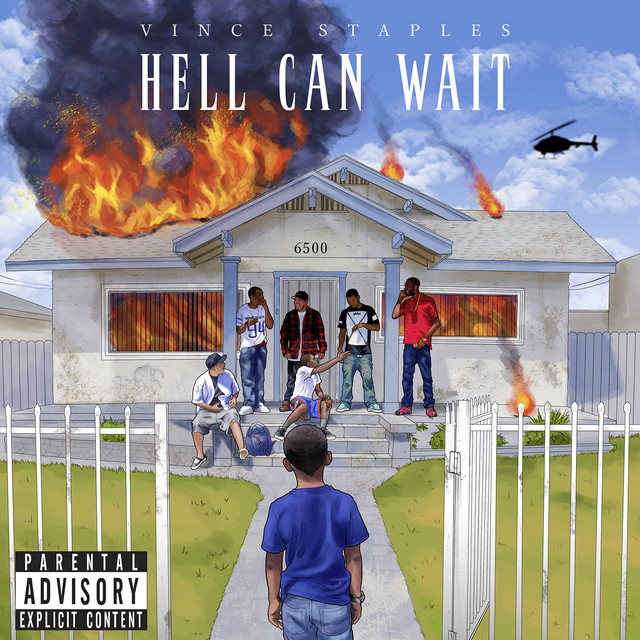
Vince Staples, born and raised around the street culture of Long Beach, wanted the art for Hell Can Wait EP to reflect his mindset during the summer between his 9th and 10th grade, and his values at the time. So he tapped Filipino artist Philip Lumbang to draw a picture based on a real live picture in front of his grandmother’s home — save the burning house, helicopter, and young boy staring at the crew — to capture this influential season in his life. The highly dramatic rendering has Staples and his friends kicking it on the matriarch’s stoop while his nephew (who actually appears in the “Screen Door” video) attentively watches on. While they are hanging out, the crew seems oblivious to the burning house right in back of them. There are no signs that the embers are singeing their back hairs. At no point in the art does any seem alarmed at anything … not even the blackbird flying above the house in the clear blue sky. The guys don’t, but the kid does. The kid is digesting it all, noting the 6500 address on the home (a nod to the 65th Street family that gave so much game to the young rap star).
A reflective Staples bears it all, unapologetically, but also seems like an artist who has no problem honestly unpacking his growth. His truth is this: life is complicated … growth is possible … and when there is so much to do to move a young boy passed even the textured circumstances of his development into a man … hell absolutely must wait.
48. Eminem, The Marshall Mathers LP

Many think that the Hitsville, U.S.A. (the Motown museum) is the most iconic house in pop music in Detroit. They might be wrong. After Eminem featured the house located 19446 Dresden Street on the cover of his The Marshall Mathers LP and The Marshall Mathers LP II albums, many have made this a shrine to rap excellence. Let’s face it, it is the childhood home of one of Hip-Hop’s most influential voices (and pens). Dark, shadowy, and grim, the image paints for Slim Shady the memory of where he came from — pointing to his struggle to overcome childhood trauma. He once said about using the house, “I had mixed feelings because I had a lot of good and bad memories in that house. To go back to where I grew up and finally say, ‘I’ve made it’, is the greatest feeling in the world to me.”
49. Cardi B, Invasion of Privacy
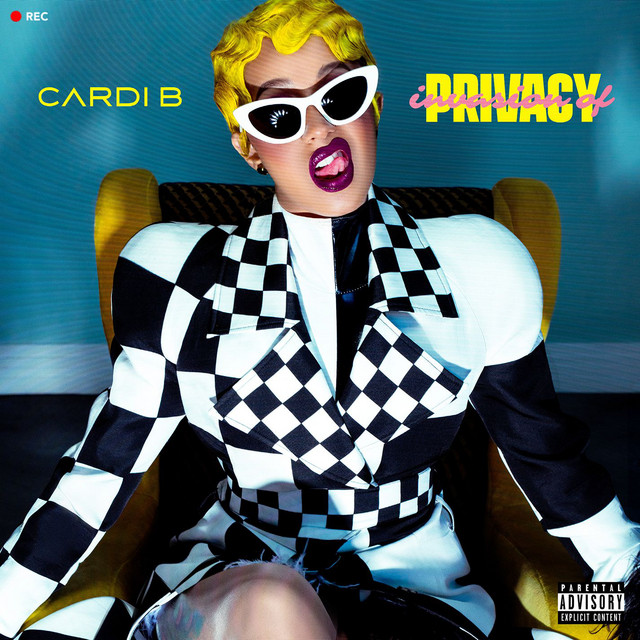
Cardi B was not even born when MTV was pumping Max Headroom as the avatar most representative of a generation. However, in 2018, she conjured up the character for her album Invasion of Privacy. Outfitted in a white and black checkered suit, the Bronx beauty is portrayed as a caricature, aptly capturing the spirit of the project. Her bright yellow kitten wig is only but one element of animation that stands out. Another of course is her crooked smile, as if to say the joke is on all of you. The 80s inspired cover was retro and futuristic at the same time, encouraging us to believe that Cardi also has that level of generational stay-power.
50. Boogie Down Production, Criminal Minded
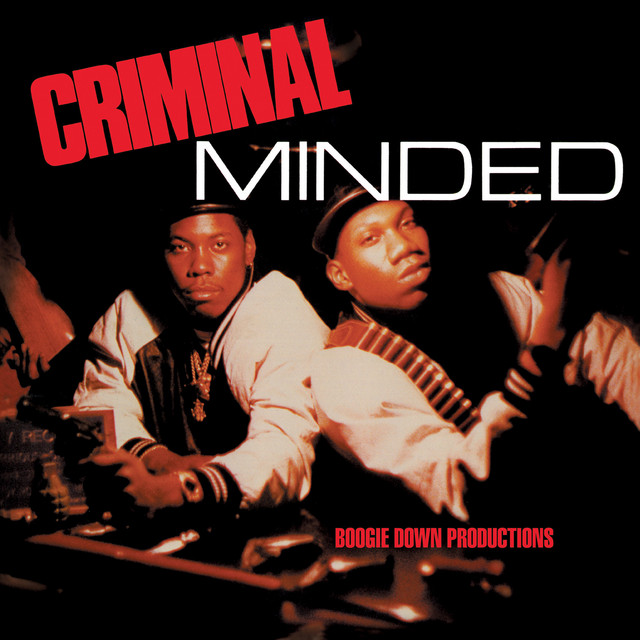
The only BDP album that featured DJ Scott La Rock, the art on the Criminal Minded cover was meant to convey what the new incarnation of 1960s freedom fighters would look like as 1987 Hip-Hoppers. It was a stark contrast to what the street rappers were talking about back then … KRS1 explained to MTV in 2010, “The idea was revolutionaries. If you look at the cover of Criminal Minded, that’s what we were saying modern-day Black Panthers are. I had the gun belt going over the shoulder, grenades. That wasn’t hood. It wasn’t like [we] had guns on the table like we were drug dealers — we had grenades.” Scott La Rock with the blammy and with a steely-eyed Parker, fans should have known from the start that Boogie Down Production was going to transform rap music into a space where the streets, consciousness, and lyricism collided. And we are all the better for that.
